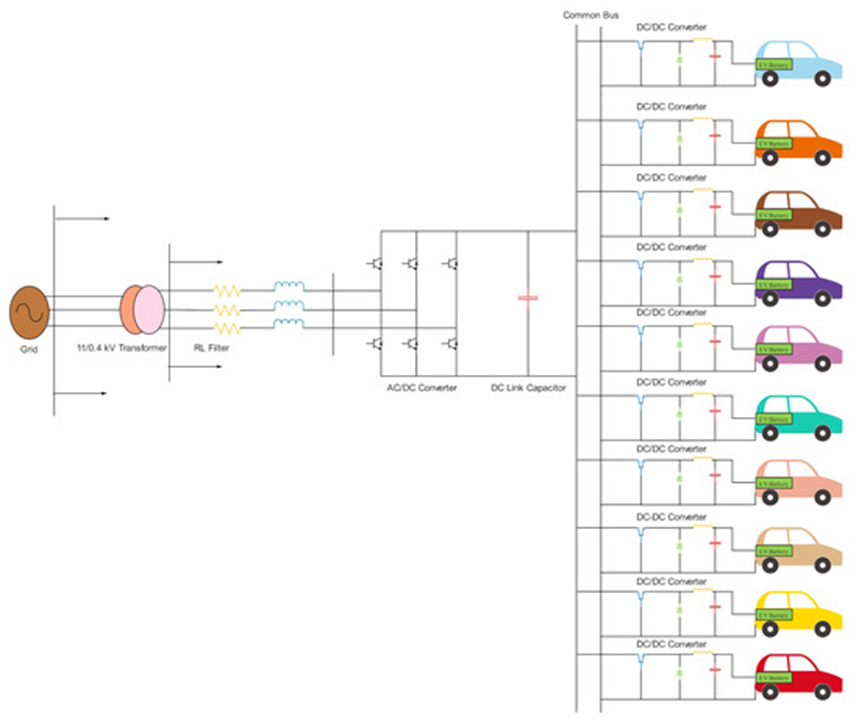Using an Intelligent Control Method for Electric Vehicle Charging in Microgrids
This paper aims to present an application of an intelligent control method to a bidirectional DC fast charging station with a new control structure to solve the problems of voltage drops and rises.

Figure 1. Configuration of a grid-connected EV system.
Recently, electric vehicles (EVs) that use energy storage have attracted much attention due to their many advantages, such as environmental compatibility and lower operating costs compared to conventional vehicles (which use fossil fuels). In a microgrid, an EV that works through the energy stored in its battery can be used as a load or energy source; therefore, the optimal utilization of EV clusters in power systems has been intensively studied. This paper aims to present an application of an intelligent control method to a bidirectional DC fast charging station with a new control structure to solve the problems of voltage drops and rises. In this switching strategy, the power converter is modeled as a DC fast charging station, which controls the fast charging of vehicles with a new constant current or reduced constant current method and considers the microgrid voltage stability. The proposed method is not complicated because simple direct voltage control realizes the reactive power compensation, which can provide sufficient injected reactive power to the network. As a result, the test is presented on a fast charging system of electrical outlets with a proposed two-way reactive power compensation control strategy, in which AC/DC converters are used to exchange two-way reactive power to maintain the DC link voltage as well as the network bus voltage in the range of the basis. This charging strategy is carried out through the simulation of fast charge control, DC link voltage control, and reactive power compensation control to adjust the voltage and modify the power factor in the MATLAB software environment and is then verified. Finally, the results indicate that the proposed method can charge with high safety without increasing the battery’s maximum voltage. It can also significantly reduce the charging time compared to the common CV mode.
Authors: Samaneh Rastgoo, Zahra Mahdavi, Morteza Azimi Nasab, Mohammad Zand, and Sanjeevikumar Padmanaban
In the same category
- A Smart Battery Management System for Electric Vehicles Using Deep Learning-Based Sensor Fault Detection
- Autel Energy Europe at AEC 2024: Pioneering the Future of Ultra-Fast EV Charging
- Baden-Württemberg International: Your partner for a successful expansion
- Business Region Goteborg : Gothenburg - Pioneering tomorrow's mobility
- Charging Electric Vehicles Today and in the Future
- Comparative Study of Permanent Magnet, Conventional, and Advanced Induction Machines for Traction Applications
- Design Methodology and Circuit Analysis of Wireless Power Transfer Systems Applied to Electric Vehicles Wireless Chargers
- Designing High-Power-Density Electric Motors for Electric Vehicles with Advanced Magnetic Materials
- Energy and Environmental National Assessment of Alternative Fuel Buses in Morocco
- Energy Management and Optimization of Large-Scale Electric Vehicle Charging on the Grid
- Fuel Cell Hybrid Electric Vehicles: A Review of Topologies and Energy Management Strategies
- Numerical Simulation of Cooling Plate Using K-Epsilon Turbulence Model to Cool Down Large-Sized Graphite/LiFePO4 Battery at High C-Rates
- Using an Intelligent Control Method for Electric Vehicle Charging in Microgrids
- Will Utrecht become the world's first bidirectional city?